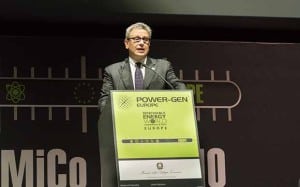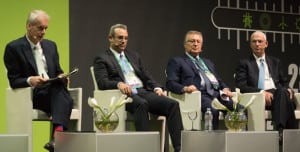Utility Paradigm Changing Globally in Response to Distributed Energy and Digitization
Enrico Viale, head of global thermal generation for the Italian energy company Enel, kicked off an international power industry event yesterday with a keynote presentation describing the “needs” of utilities in the future.

With more than 100 power plants in 33 nations generating and distributing energy to more than 60 million customers, Enel’s multi-platform fleet is rapidly changing. “We are in the middle of a transition to a new energy paradigm characterized by the rise of renewables and distributed energy. These pose challenges to traditional generation and power network systems,” he told attendees at Power-Gen Europe in Milan, Italy, on July 21.
From Viale’s global perspective, all utilities are being influenced by four major factors: “persistent market volatility, a growing environmental culture, calls for sustainability, and the megatrend of digitalization.”
Under his leadership, Enel is poised to become one of the greenest energy providers worldwide. “We should take very seriously the COP-21 outcomes through the demonstration of an environmental culture,” he said. To reduce CO2 fast enough to achieve a less than a 2-degree temperature rise, “at Enel, we are reducing emissions by retrofitting plants with state-of-the-art technology, increasing investment in renewables, and closing older plants. And there will be no more greenfield coal units built. Our group’s target is to reach carbon neutrality by 2050.” Other producers, he believes, should follow Enel’s model.
Regarding market perspectives, he noted, “we are seeing a decoupling of GDP from power consumption.” Falling prices, including negative pricing in Germany (see “Germany’s Energiewende at a New Turning Point”), are “signals that represent difficulty for the whole sector.”
Thermal generation models now work in a different context. Solar prices are extremely competitive with conventional technologies, even without subsidies. Quoting from a recent Bloomberg New Energy Finance (BNEF) study predicting that pricing for wind and solar will overtake gas generation by 2027 and coal generation a decade later, Viale echoed that, “in the future wind will cost 40% less than currently and solar will drop by 60%.”
This scenario comes with consequences, though Viale called them needs. “A much higher generation efficiency is the first need. The second is flexibility for our plants and the way we do business, and lastly, the decommissioning of many units.”
Viale said that while at least “five main utilities have said that they plan to shut down 20 GW of capacity” in Europe, Enel had started a project called Future-E, which has targeted 23 “marginal plants” comprising over 13 GW of installed power for transformation to “a new use” other than generation.
Related to the environmental culture is another trend: sustainability. “Companies can no longer afford to separate sustainability from profitability. Those that fail to position themselves in these environments risk being left behind or becoming obsolete.”
New Disruptive Technologies
Viale also touched on one of the conference buzzwords. “Digitalization,” he said, represents “the fourth industrial revolution.” With the exponential growth of the internet of things, “the 50 billion connected devices coming online over the next five years will completely change the way we mange our businesses,” he predicted.
Finally, Viale said, “we cannot talk about energy sector changes without talking about storage. It will change the way operators and consumers produce, consume, and dispatch energy.” Though it will cause “lots of stress,” storage will create “many opportunities” too.
Other Industry Leaders See Stronger Future for Fossil Fuels
During the afternoon plenary chaired by BBC Hard Talk’s Stephen Sackur with a panel comprising Italian power producers and international equipment providers, several speakers, in particular Paul McElhinney, president and CEO of Power Services for GE Power, seemed to ignore Vitale’s warnings, let alone the BNEF study. Suggesting instead that gas- and coal-fired power will continue to increase, McElhinney exclaimed, “I am an optimist! There are 1.2 billion with no access to power today. There are another 500 million with access to unreliable power—that translates into a global demand of 50% more power.”

Sackur expressed surprise that McElhinney and the other panelists believed that fossil fuel usage would expand following COP21. Indeed, McElhinney seemed rather dismissive of the threats of rising CO2 emissions as well as other greenhouse gasses, including the effects of fugitive methane, as more gas-fired power comes online. “The technology exists today to significantly reduce CO2 emissions from every coal-burning plant in the world. The world can achieve that using currently available technology. Even 20- to 30-year-old steam plants can be retrofitted to reduce emissions,” he said.
Perhaps not as bullish, Gianfilippo Mancini, CEO of Italian energy provider Sorgenia, stated his belief that conventional power will continue to provide baseload and back-up generation. “An example I give is on the 31st of July last year in Italy, a hot day without wind, also had the scenario later that day of no sun. Fossil-powered stations stepped in to provide 70% of generation. It tells us that the way these power stations will work over the next decade will be completely different.”
That said, on the previous day, delegates had toured the Sorgenia-owned Bertonico-Turano Lodigiano combined cycle gas turbine plant outside Milan. Once a flagship facility projected to consistently operate at 70% capacity, currently it’s rarely run above 20%.
—Lee Buchsbaum (www.lmbphotography.com), a former editor and contributor to Coal Age, Mining, and EnergyBiz, has covered coal and other industrial subjects for nearly 20 years and is a seasoned industrial photographer.